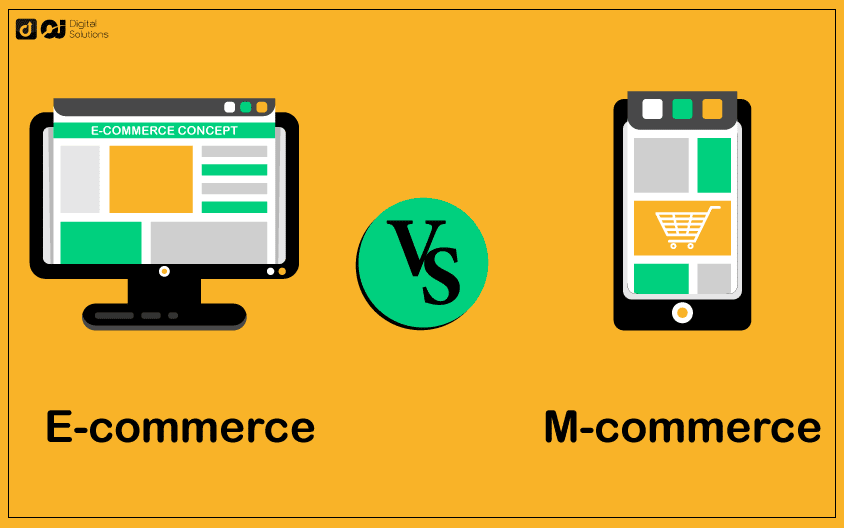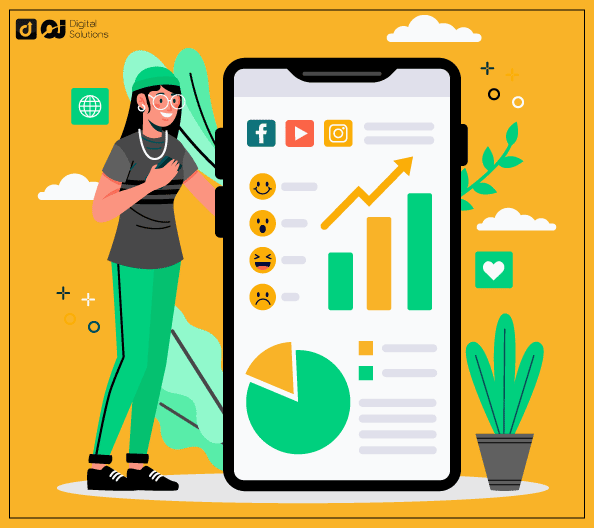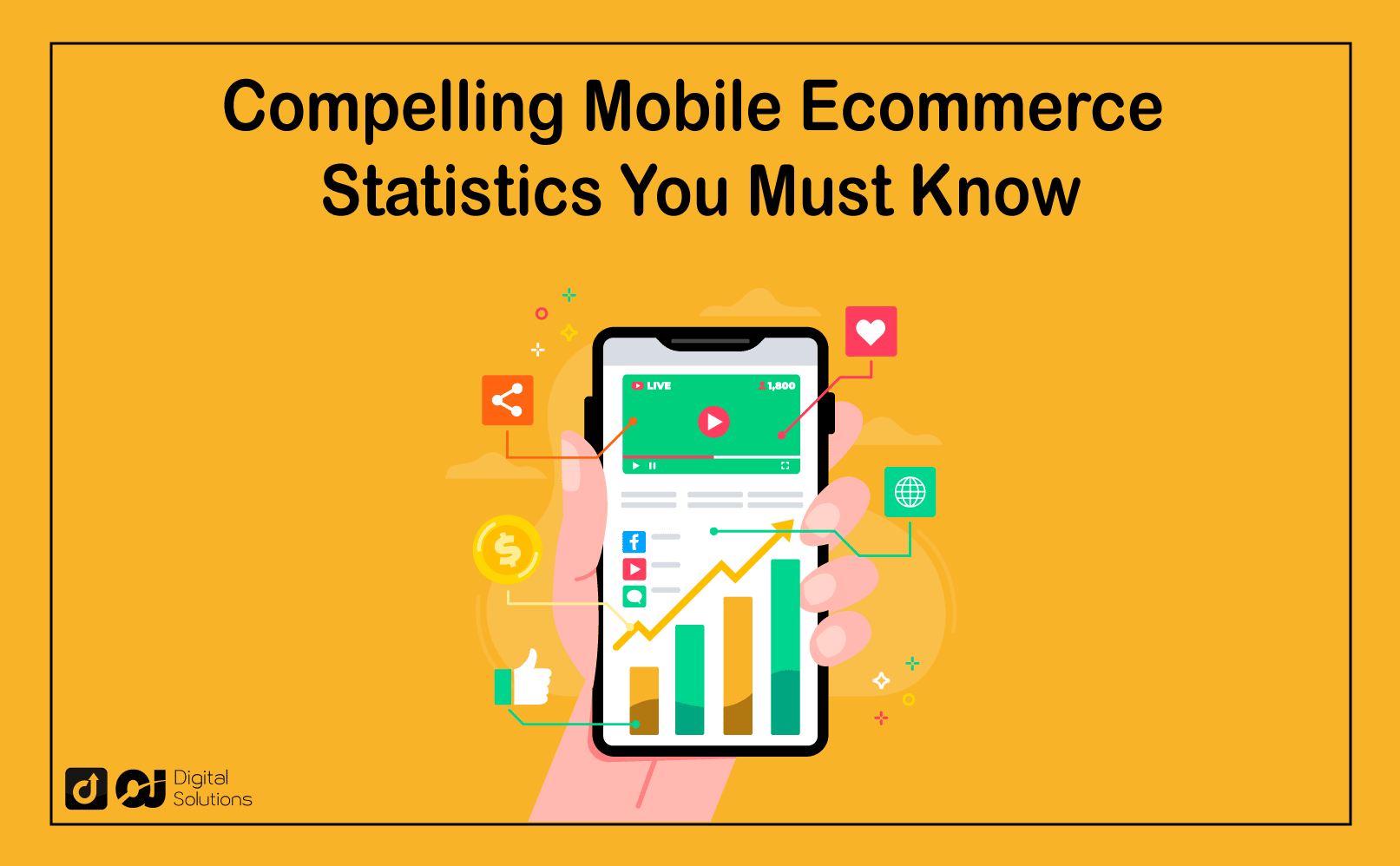Ecommerce is an ever-changing landscape.
Today, more and more people do their online shopping on smartphones rather than desktop computers.
If you want to know more about these mobile users and their online shopping habits, you’ve come to the right place.
I’ve collected several compelling mobile ecommerce statistics to help you understand mobile consumer behavior (how consumers shop online using their mobile phones).
Let’s begin.
What Is Mobile Ecommerce?

Mobile ecommerce (also known as mobile commerce or m-commerce) involves using mobile devices like smartphones and tablets for commercial online transactions, including purchasing from online stores.
Today, more and more people use mobile devices for online purchases because doing so is convenient.
Smartphone owners (or tablet owners) can easily browse products and purchase online. They don’t need to log on to their desktop computer or visit a physical store.
Most online retailers have made their websites mobile-friendly. Some have even developed dedicated mobile apps, integrated mobile chatbots into their websites, and included augmented reality features.
If you’re a business owner, you must do the same and focus on the mobile experience.
As an ecommerce store owner, you must also ensure the security of mobile users’ data, including their financial information.
Addressing these concerns will be crucial for business success as m-commerce continues to rise.
What Is the Difference Between E-commerce and M-commerce?

Electronic commerce or ecommerce involves any online commercial transaction, regardless of device. Thus, all mobile commerce is ecommerce.
Mobile commerce or m-commerce refers to commercial transactions conducted via mobile devices. Thus, not all ecommerce is m-commerce.
Many businesses and ecommerce retailers now use the following tools to facilitate and promote mobile transactions.
- Mobile apps (including mobile banking apps)
- Mobile websites
- Mobile point-of-sale (POS) systems
- Mobile payment options
- Mobile coupons
Offer these options to improve the experience of your mobile customers, and keep in mind the cost of developing a banking app.
Mobile Ecommerce Statistics

Here are some interesting mobile commerce statistics you need to know.
- Retail m-commerce sales increased to $359.32 billion in 2021.
- Analysts expect retail mobile commerce sales in the US to reach $728.28 billion by 2025, making up 44.2% of all online retail sales.
- In 2024, mobile commerce will account for 42.9% of all ecommerce, amounting to $620.97 billion.
- Smartphones drive mobile commerce growth. The US trade volume from mobile sources will rise from $128.4 billion in 2019 to $553.28 billion by 2024.
- M-commerce accounted for 34% of all e-commerce sales in 2017
- Tablets are significantly boosting the success of m-commerce, despite having a lower volume than smartphones. Insider Intelligence projects tablet sales will reach $64.06 billion in 2022.
- The growth of m-commerce has slowed in recent years. From 2016 to 2021, the average year-over-year growth rate of m-commerce was 29.8%.
- The money made from m-commerce sales in 2021 is over 3.5 times higher than m-commerce sales in 2016.
- Consumers now spend an average of 234 minutes per day using mobile devices in the US— up from 188 minutes in 2016. This figure represents a 24.5% increase over five years.
- M-commerce market share has also increased from 52.4% in 2016 to 72.9% 72.9% at present.
- M-commerce sales have increased to 39.1% of overall ecommerce sales.
- Today, almost three out of every four dollars spent on online purchases come from mobile devices.
- Mobile ecommerce sales will reach $710 billion by 2025.
- M-commerce sales took off in 2020, increasing by 18% from the previous year due to the COVID-19 pandemic.
- The mobile commerce market will account for 41.6% of all ecommerce sales by the end of 2022.
- There will be more than 187 million active mobile buyers in the US by 2024.
- Users spent 24 more minutes daily on a mobile device in 2020.
- According to estimates, there are now 187.5 million active mobile shoppers.
- Desktop users have a slightly higher conversion rate of 3.9% than mobile users at 3.5%.
- 31% of mobile consumers are more inclined to purchase if their device has a bigger screen.
- Tablet and mobile phone users spent 100 billion hours using mobile shopping apps in 2021.
- 54% of all completed mobile commerce payment options are from specialized mobile shopping apps.
- Mobile commerce retail sales in the UK decreased slightly in 2021 from 16.5% to 15.6%.
- Mobile shopping app revenue increased to $3.56 trillion in 2021.
- Mobile ecommerce accounted for 7.3% of all online retail in the US in 2021.
Mobile Traffic and Usage Statistics
- Over 85% of Americans are smartphone owners.
- There are now around 6.64 billion mobile phone users worldwide.
- There are about 100 million tablet owners in the US.
- 79% of smartphone users bought something online in the last six months.
- People used smartphones for nearly 40% of all ecommerce website purchases during the 2018 holiday season.
- 80% of customers use a mobile device while in-store shopping to research products, check and compare prices, or look up alternative stores.
Amazon Mobile Shopping Statistics

Ecommerce is moving toward a mobile-first strategy, but Amazon customers still prefer desktop to mobile when buying products.
More than half (67%) of Amazon customers prefer shopping on a desktop or laptop over a mobile phone.
24% of consumers said they preferred using mobile phones for online shopping.
Various age groups have different preferences for devices.
Those under 35 prefer mobile phones and comprise the majority of mobile shoppers.
Online shoppers 55 and older prefer laptop or desktop computers.
Research also shows that consumers are more inclined to browse on a mobile phone and purchase on a desktop.
Amazon Shopping is the most popular mobile shopping app on iOS, with 20.8 million daily active users.
Making Mobile Payments
As mobile online shopping continues to rise, so does the use of mobile wallets for mobile payments.
A mobile wallet allows smartphone users to make purchases, store loyalty cards, and manage finances from their phones.
Approximately 66% of Americans have switched from traditional payment methods to mobile payments (ex., mobile wallets) when making online purchases.
Gen Zers have an 84.6% adoption rate for mobile payments, while Millennials have a rate of 81.3%.
Here are some of the most popular options in the mobile payments market today:
Apple Pay
As mobile payments go, Apple Pay is one of the most popular options.
There are currently over 507 million Apple Pay users worldwide.
This mobile payment method is available on all Apple devices and allows users to store their debit and credit cards, loyalty cards, and tickets.

Google Pay
Google Pay is available on all Android devices.
Like Apple Pay, Google Pay allows users to store their debit and credit cards, loyalty cards, and tickets. Users can also manage their gift cards.

Samsung Pay
This mobile wallet is available on select Samsung devices.
Samsung Pay has magnetic secure transmission technology, allowing you to transact at traditional credit card terminals.

PayPal
This long-standing online payment system now offers a mobile wallet option, allowing users to connect to their PayPal account for easy transfers and bill payments.
Frequently Asked Questions (FAQs)
What Are the Three Types of Mobile Ecommerce?
The three types of mobile commerce are mobile shopping, mobile banking, and mobile payments.
Mobile shopping means purchasing products or services through a mobile device, such as a smartphone or tablet.
Mobile banking lets customers access their financial accounts and conduct online transactions via their mobile phones.
Mobile payments involve using a mobile device to pay for transactions.
What Are the Challenges of Mobile Commerce?
One challenge of m-commerce is security, as the transmission of sensitive financial and personal information can be vulnerable on mobile phones.
Another challenge is technical difficulties, such as website crashes and slow load times.
Additionally, designing a user-friendly and visually appealing interface for smartphone users can be challenging due to the small screens of mobile phones.
Nevertheless, businesses can overcome these challenges with constant technological advancements.
What Is the Importance of Mobile Commerce?
M-commerce is essential because it caters to the growing number of consumers who prefer using mobile phones for shopping and financial transactions.
It offers convenience and a personalized customer experience that can increase online sales.
M-commerce also allows improved targeting and customer engagement through customer data collection and various communication methods.
What Is the Future of Mobile Commerce?
The future of mobile commerce will likely involve more integration and convenience for customers and mobile payment advancements.
The technology behind mobile phones and security measures will also continue to improve.
Why Is Mobile Commerce Growing So Fast?
M-commerce is growing because mobile phones are now vital to daily consumer life.
People use mobile phones and tablets to communicate, shop, pay bills, and do other activities.
People’s reliance on mobile phones has caused businesses to adapt and offer more m-commerce options.
The convenience and security of mobile transactions have also improved, resulting in people trusting mobile shopping apps and payment methods more.
The Bottom Line
I hope the mobile commerce statistics you learned in this article have shown you the significance of taking a mobile-first approach to ecommerce.
Prioritizing your mobile customers will be crucial to your success if you run an online business.
For more ecommerce insight, you should also learn online grocery shopping statistics.






